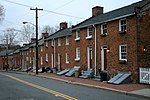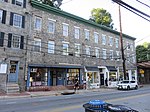Mount Gilboa Chapel
1859 establishments in Maryland19th-century churches in the United StatesAfrican-American cemeteries in MarylandAfrican-American history of Baltimore County, MarylandAfrican Methodist Episcopal churches in Maryland ... and 6 more
Benjamin BannekerChurches completed in 1859Churches in Baltimore County, MarylandChurches on the National Register of Historic Places in MarylandNational Register of Historic Places in Baltimore County, MarylandOella, Maryland

Mount Gilboa Chapel is a historic African Methodist Episcopal Church located in Oella, Maryland, United States. It is a small stone church measuring 28 feet by 42 feet, built about 1859 by free African Americans. The front façade is ashlar masonry, but the sides and rear are of rubble.
Excerpt from the Wikipedia article Mount Gilboa Chapel (License: CC BY-SA 3.0, Authors, Images).Mount Gilboa Chapel
Westchester Avenue,
Geographical coordinates (GPS) Address Website Nearby Places Show on map
Geographical coordinates (GPS)
| Latitude | Longitude |
|---|---|
| N 39.274930555556 ° | E -76.778583333333 ° |
Address
Mt. Gilboa A.M.E. Church
Westchester Avenue 2312
21228
Maryland, United States
Open on Google Maps







